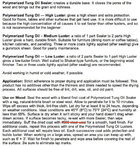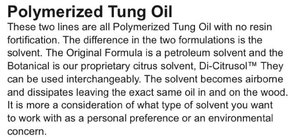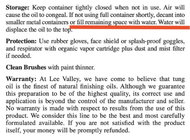Reply
Sorry, Tim, I hadn’t suggested that you discounted science, I just thought that because you spoke with such certainty on this point, you might have some data. Like you, I have an interest in this issue and have tried to find good information: when I saw your categorical statement that UV light had nothing to do with curing oil finishes, I hoped you had some data.
The common view that UV helps curing appears to start with the uncontentious proposition that UV light causes oxidation / free radical polymerisation, which is what oil finish curing is about. However, to be confident that this translates into faster curing times for drying oils, we want the evidence that you and I are looking for.
Doń Należyty is a woodworker who seems to obsess about linseed oil and how to apply and cure it. There is a video on YouTube (on Lee Stoffer’s channel) of him giving a talk on this. He purports to have done a lot of testing and he insists on sunlight as one of the keys to efficient curing of linseed oil. It was that video that originally got me thinking about this several years ago.
You mention not having seen manufacturers recommending this, but this is what I have seen.
- Mike Meredith, the “doctor” (professor of biochemistry) from Doctor’s Woodshop, states of walnut oil that “Use of a UV light will speed up the curing process, as will raising the room temperature.”
- The chemist (who claims to have a doctorate and 35 years of formulating and testing wood finishes) at Swing Paints (maker of the Circa 1850 line of tung oil and other finishes) received the question about tung oil “I can tell you a hot day and plenty of sun will decrease the drying time. Is it the heat, sun or both?” and answered as follows: Both heat (IR radiation) and UV radiation will accelerate the polymerizion of tung oil. Heat speeds up most chemical reactions, so curing is best done in a warm environment. For polymerization reactions (curing of tung oil into polymerized tung oil), the UV radiation will accelerate the formation of free radicals, and therefore increase the rate of curing.
- Sage, the maker of (expensive but excellent) Allback linseed oil paints, comes at the point from the other direction, advising that: “reduced exposure to full-spectrum UV light can increase drying and curing times.”
- The UK manufacturer of linseed oil paint Brouns & Co. says on its website: “Linseed oil dries primarily by exposure to UV-light and oxygen.” and goes on to describe the testing they did with a UV light specialist to establish this. It does not look very scientific, but they seem to like the idea.
Not conclusive of anything, but at least some reputable manufacturers seem to see a benefit from UV light curing.
As for studies, I didn’t do a review of the literature, but these came up on a quick search:
- The paper “Study on photocuring activity of tung oil under UV light” (Journal of Functional Materials) does conclude that UV light helps curing: “The main function of oxygen was to form hydroperoxides with the free radicals formed after the reaction of hydrogen extraction of tung oil under UV light, which promoted the oxidative polymerization of tung oil.”
- The paper “Review of the kinetics and simulations of linseed oil autoxidation” in the journal “Progress in Organic Coatings” includes these statements: Drying oils are natural, bio-based oils that harden or “dry” into a solid film when exposed daylight and ambient oxygen…The reaction mechanism of triglycerides is an autoxidation process that proceeds under the influence of oxygen and light…Initiation can occur spontaneously, or with the aid of UV light.”
So, there is enough out there that, if I were wanting to expedite the curing of a drying oil, I would try a UV lamp. But like you, I would be interested to see some more testing and data on this. At this time I don’t have the certainty that you have to make a confident assertion that UV light adds nothing to curing drying oils.
Gord




